Nelson River
The Nelson River is a river of north-central North America, in the Canadian province of Manitoba. The river drains Lake Winnipeg and runs 644 kilometres (400 mi) before it ends in Hudson Bay. Its full length (including the Saskatchewan River and Bow River) is 2,575 kilometres (1,600 mi), it has mean discharge of 2,370 cubic metres per second (84,000 cu ft/s), and has a drainage basin of 1,072,300 square kilometres (414,000 sq mi), of which 180,000 square kilometres (69,000 sq mi) is in the United States.[2]
| Nelson River | |
|---|---|
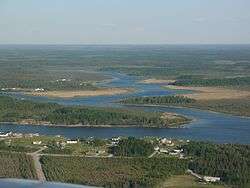 Nelson River near Norway House | |
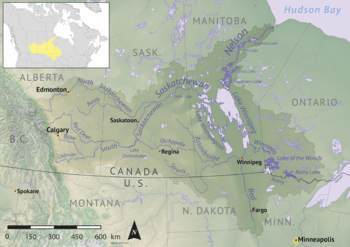 Map of the Nelson River drainage basin | |
| Native name | Powinigow Sipi |
| Location | |
| Country | Canada |
| Province | Manitoba |
| Physical characteristics | |
| Source | Lake Winnipeg |
| • coordinates | 53°41′20″N 97°50′52″W |
| • elevation | 217 m (712 ft) |
| Mouth | Hudson Bay |
• coordinates | 57°5′5″N 92°30′8″W[1] |
• elevation | 0 m (0 ft) |
| Length | 644 km (400 mi)[2] |
| Basin size | 1,072,300 km2 (414,000 sq mi)[3] |
| Discharge | |
| • average | 2,370 m3/s (84,000 cu ft/s)[2] |
| Basin features | |
| Tributaries | |
| • left | Burntwood River, Grass River |
Geography
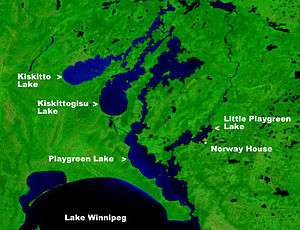
The Nelson River flows into Playgreen Lake from Lake Winnipeg then flows from two channels into Cross Lake. The east channel and the Jack River flow from the southeast portion of the lake into Little Playgreen Lake then the Nelson east channel continues in a northerly direction passing through Pipestone Lake on its way to Cross Lake. The west channel flows out of the north ends of Playgreen Lake, Kiskittogisu Lake and Kiskitto Lake into Cross Lake at the Manitoba Hydro's Jenpeg Generating Station and Dam. From Cross Lake it flows through Sipiwesk Lake, Split Lake and Stephens Lake on its way to the Hudson Bay.[4][5]
Since it drains Lake Winnipeg, it is the last part of the large Saskatchewan River system, as well as that of the Red River and Winnipeg River. Devils Lake is unusual for a glacial lake in being presently closed, also has been known to overflow into the Red River for at least five separate periods since deglaciation.[6]
Besides Lake Winnipeg, its primary tributaries include the Grass River, which drains a long area north of Lake Winnipeg, and the Burntwood River, which passes through Thompson, Manitoba.
The river flows into Hudson Bay at Port Nelson (now a ghost town), just north of the Hayes River and York Factory. Other communities upriver from there include Bird, Sundance, Long Spruce, Gillam, Split Lake, Arnot, Cross Lake, and Norway House.
Transportation
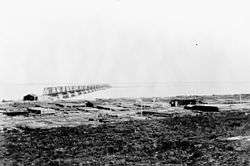
North America has just one port on the Arctic Ocean, linked to the North American railway grid—at Churchill, Manitoba, at the mouth of the Churchill River.[7] Originally port facilities were to be built at Port Nelson, a rail link was to be built to Port Nelson. Practical problems led to the port's relocation to Churchill. Those difficulties included a much greater need for dredging, because the Nelson River's water was more full of silt, in absolute terms, and carried more silt because of its greater volume of flow. The Nelson estuary is broad and shallow, so port facilities would have to be constructed on artificial islands created in the middle of the river, that would require a causeway approximately a kilometer long to reach.
History
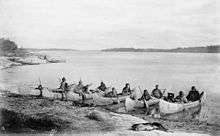
The river was named by Sir Thomas Button, a Welsh explorer from St. Lythans, Glamorganshire, who wintered at its mouth in 1612, after Robert Nelson, a ship's master who died there. At that time, the Cree people who lived along its banks called it Powinigow or Powinini-gow, which may have meant "the Rapid Strangers' river".[8] The area was fought over for the fur trade, though the Hayes River, whose mouth is near the Nelson's, became the main route inland.
Fort Nelson, a historic Hudson's Bay Company trading post, was at the mouth of the Nelson River at Hudson Bay and was a key trading post in the early 18th century. After his pivotal role in establishing the Hudson's Bay Company, Pierre Esprit Radisson, noted French explorer, was chief director of trade at Fort Nelson during one of his sustained periods of service to England. Today, Fort Nelson no longer exists. Port Nelson, the abandoned shipping port, remains on the opposite side of the river mouth on Hudson Bay.
The Nelson River's huge volume and long drop make it useful for generating hydroelectricity. Flooding caused by damming of the river has provoked bitter disputes with First Nations in the past although the Northern Flood Agreement was created in the 1970s to help offset the damages caused by flooding.[9]
"Travelling up the Nelson River, it’s easy to see the impacts of hydro development. The once-pristine water is now silty and not to be trusted for drinking. Trees fall into the river everywhere along the shore, thanks to erosion caused by constantly fluctuating water levels. Ancient graves are being exposed, and sacred sites are now under water. What was once a highway for hunters is now dangerous to travel in winter, as the location of ice pockets created by flooding and retreating water cannot be predicted. A river that was once the basis for life has become deadly." Peter Kulchyski 2012[9]
See also
- List of longest rivers of Canada
- Nelson River Hydroelectric Project
- List of Manitoba rivers
- Manitoba Hydro
- Nelson River Bipole
References
- "Nelson River". Geographical Names Data Base. Natural Resources Canada. Retrieved 2010-11-24.
- Atlas of Canada
- "Canada Drainage Basins". The National Atlas of Canada, 5th edition. Natural Resources Canada. 1985. Retrieved 12 November 2014.
- "Natural Resources Canada-Canadian Geographical Names (Playgreen Lake)". Retrieved 2015-01-07.
- "Atlas of Canada Toporama". Retrieved 2015-01-07.
- Comments on Statements by North Dakotas Senator Kent Conrad in His Letters to the Great Lakes Commission Regarding the Commission’s January 23, 2003, Letter to Senators Urging Support of Senator McCain’s Amendment on the Devil’s Lake Outlet in the Omnibus Appropriations Bill for Fiscal Year 2003 Archived March 31, 2012, at the Wayback Machine
- David Malaher (Autumn 1984). "Port Nelson and the Hudson Bay Railway". Manitoba History. Manitoba Historical Society (8). ISSN 0226-5036. Retrieved 2010-08-20.
- David Thompson's Narrative of his Explorations in Western America 1784-1812. Toronto: The Champlain Society. 1916. p. 8. ISBN 1164617699.
- Peter Kulchyski (February 28, 2012). "Flooded and forgotten: Hydro development makes a battleground of northern Manitoba". Briar Patch Magazine. Retrieved February 13, 2013.
External links
| Wikimedia Commons has media related to Nelson River. |